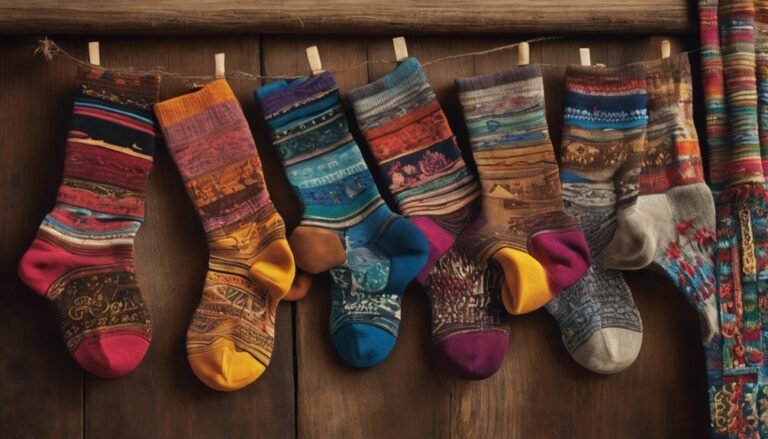Why Wool Socks Are Perfect for Both Summer and Winter
Wool socks are perfect for both summer and winter due to their remarkable properties. They provide excellent temperature regulation, keeping your feet cool in the summer and warm in winter. Moisture-wicking fibers draw sweat away, ensuring dry comfort and preventing blisters. Plus, wool's natural elasticity and durability enhance the lifespan of your socks while fighting odors. With these features, you can adapt to any season comfortably. Discover more about maximizing your sock experience.
The Unique Properties of Wool

Wool's unique properties make it an exceptional choice for socks throughout the year. When considering wool types, you'll find various options, each offering distinct advantages. Merino wool, for instance, is known for its softness and moisture-wicking abilities, making it ideal for active wear. In contrast, heavier wool types provide insulation, perfect for colder climates.
Understanding wool sourcing is vital, as ethically sourced wool not only guarantees animal welfare but also enhances quality. Sustainable practices in wool production contribute to durability and comfort, allowing you to enjoy your socks longer without compromising on performance. By choosing the right wool type and prioritizing responsible sourcing, you can experience the true benefits of wool socks, enjoying freedom in both comfort and style year-round.
Temperature Regulation: Staying Cool in Summer
Wool socks provide excellent breathability and moisture-wicking properties, essential for maintaining comfort in summer heat. Their natural temperature regulation helps keep your feet cool by allowing excess heat and moisture to escape. This unique combination guarantees that you stay comfortable, even on the hottest days.
Breathability and Moisture-Wicking
When it comes to staying cool in summer, breathability and moisture-wicking properties are essential for comfort. Wool socks, made from breathable fibers, excel in moisture control, ensuring your feet stay dry even in sweltering heat. This functionality allows you to feel unrestricted, embracing the freedom of movement without discomfort.
| Feature | Wool Socks | Synthetic Socks |
|---|---|---|
| Breathability | Excellent | Moderate |
| Moisture Wicking | Superior | Lacks Efficiency |
| Comfort Level | High | Variable |
Choosing wool means choosing a sock that adapts to your body's needs, allowing you to enjoy your summer adventures without the worry of sweaty, uncomfortable feet.
Natural Temperature Regulation
While many materials struggle to maintain comfort in fluctuating temperatures, natural temperature regulation is a hallmark of wool socks. Wool's inherent properties enable effective temperature adaptation, ensuring your feet stay cool during the summer months. Here's how wool excels:
- Natural Insulation: Wool fibers trap air, providing insulation without overheating, allowing your feet to breathe.
- Moisture Management: Wool can absorb and release moisture, preventing dampness that can lead to discomfort and overheating.
- Thermoregulation: The structure of wool allows for consistent temperature stabilization, promoting comfort regardless of external conditions.
Insulation Benefits for Winter Warmth
Although many materials claim to provide warmth, few match the insulation benefits of wool socks during winter. Wool's unique structure traps air, creating an effective barrier against the cold. This natural insulation technique helps retain body heat, allowing you to stay warm even in frigid conditions. The warmth factors of wool are enhanced by its moisture-wicking properties, which, while not the focus here, play an essential role in overall comfort.
| Insulation Technique | Warmth Factor |
|---|---|
| Air Trapping | High insulation |
| Natural Crimp | Elasticity |
| Fiber Structure | Breathability |
| Thermal Regulation | Consistent warmth |
When you choose wool, you're opting for a reliable source of winter warmth that stands the test of time.
Moisture Management: Keeping Feet Dry
Wool socks excel in moisture management, effectively keeping your feet dry regardless of the season. This is essential for maintaining foot comfort and preventing blisters during various activities. Wool's unique properties allow it to absorb moisture while still providing breathability, ensuring your feet remain comfortable.
Here are three key benefits of wool socks for moisture management:
- Moisture Absorption: Wool can absorb up to 30% of its weight in moisture, drawing sweat away from your skin.
- Temperature Regulation: Wool fibers help regulate temperature, preventing overheating in summer and cold feet in winter.
- Breathability: The natural structure of wool allows for air circulation, facilitating evaporation and keeping your feet dry.
Embrace the freedom of all-day comfort with wool socks!
Odor Resistance: Fresh Feet Year-Round

When you choose wool socks, you're not just opting for comfort; you're also investing in odor resistance, an essential feature for maintaining fresh feet throughout the year. Wool's natural fibers possess inherent properties that provide superior odor control, effectively combating bacteria and fungi that cause unpleasant smells. This guarantees long lasting freshness even in varying temperatures. Unlike synthetic materials, wool can absorb moisture without retaining odors, allowing your feet to breathe and stay dry. Additionally, the lanolin found in wool adds another layer of protection, further enhancing its ability to neutralize odor over time. By selecting wool socks, you're assuring that your feet remain comfortable, dry, and free from unwanted smells, no matter the season or activity level.
Durability and Longevity of Wool Socks
The resilience of wool socks makes them a smart investment for anyone seeking long-lasting footwear. The unique properties of wool fiber contribute to an impressive sock lifespan, allowing you to enjoy their benefits season after season.
Consider the following advantages of wool socks:
- Natural Elasticity: Wool's natural elasticity guarantees that socks retain their shape even after extensive wear, preventing sagging and loss of fit.
- Moisture Management: The moisture-wicking ability of wool keeps feet dry, reducing the risk of wear associated with dampness and friction.
- Resistance to Wear: Wool fibers are inherently durable, showcasing remarkable resistance to abrasion, which enhances longevity.
Choosing the Right Wool Socks for Every Season
Finding the right wool socks for different seasons can greatly enhance your comfort and performance, particularly when considering their durability and moisture management. For summer, opt for lightweight socks with a thinner sock thickness. These will wick moisture away and keep your feet cool. In contrast, for winter, choose thicker, insulated wool socks that provide warmth and cushioning.
Additionally, don't overlook color selection. Lighter colors can reflect heat in warmer months, while darker shades can absorb warmth in colder conditions. Always consider the activity you'll be engaging in; hiking, running, or casual wear may require specific sock features. By tailoring your wool sock choice to the season, you guarantee peak comfort and performance year-round.
Frequently Asked Questions
Can Wool Socks Be Machine Washed and Dried?
Yes, wool socks can be machine washed, but you should use gentle washing techniques. For drying methods, air drying is best; avoid high heat to maintain the integrity and longevity of your socks.
Are There Specific Brands Known for High-Quality Wool Socks?
When you're seeking superior socks, Smartwool stands out for its cushioned comfort and quality craftsmanship. Other brands like Darn Tough and Icebreaker also deliver durable designs, ensuring your feet feel fantastic year-round.
How Do Wool Socks Compare to Synthetic Alternatives?
When comparing wool socks to synthetic alternatives, you'll find that wool excels in breathability and moisture management, keeping your feet dry and comfortable in both hot and cold conditions, unlike many synthetic options that can trap moisture.
What Thickness of Wool Socks Is Best for Different Seasons?
Think of wool socks as your personal climate control. For summer, lightweight options keep you cool, while in winter, thick insulation guarantees warmth. Choosing the right thickness helps you navigate seasonal extremes with ease and comfort.
Do Wool Socks Cause Itching or Discomfort for Sensitive Skin?
Wool socks can cause discomfort for sensitive skin due to some individuals' skin sensitivity concerns. However, many wool fiber properties, like moisture-wicking and temperature regulation, help provide comfort, potentially alleviating itching when properly chosen.







